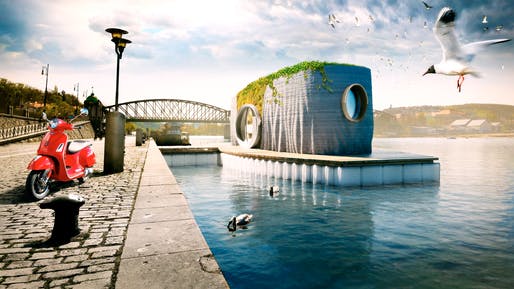They say that home is where the heart is—and for some, yes that may be in a tiny 3D printed home perched atop a pontoon boat. The 3D printing industry is ripe with alternative design and engineering concepts, and the construction realm is certainly no exception. In fact, while this may be an area that takes a lot of heat and skepticism regarding claims for homes that are built cheap and fast—3D printing for residential properties is also a great source of fascination; after all, most of us like to hope for the option of a stylish home built in a matter of days that we could easily afford and, in the future, call our own.
Many plans in the past have been hazy—or downright shady—so it is refreshing to watch a small project come to fruition on time as promised. With promises for the “first inhabitable house” in the Czech Republic, sculptor Michal Trpak and developers have actually completed their prototype by June as promised. Still meant to float on the water, the PRVOK or protozoon is now complete in České Budějovice, a large city in the Czech Republic.
And while the houseboat was technically fabricated in 22 hours, the materials still take longer to set—especially considering that 17 tons of concrete was used. The home is also being evaluated for performance, with properties like static pressure being examined—and results demonstrating that the structure can stand up to a 50-ton load.
“Despite minor issues caused by the weather, we managed to 3D print the house successfully,” said sculptor and project leader Michal Trpák in a statement. “It took us 22 hours in total and we needed 17 tons of custom-developed mixture. As the concrete will take 28 days to harden, we are completing the house, preparing the green roof, floors, all distributions, doors, windows, etc.”
The home features a curved, futuristic style with a pretty charming interior—but overall this type of real estate may not appeal to more conventional consumers, despite its ‘green’ appeal and other eco technologies like a recirculation shower, remote control capabilities, a green roof, and water and utility reservoirs. The concrete composite used in building consists of plasticizers for production of better shapes, along with a setting accelerator.
3D printed buildings and offices have been developed in Dubai, conceptualized as affordable housing for low-income families in New York, and even an entire house-printing factory was opened in Eindhoven, Netherlands. Numerous projects are underway, however, around the world—along with the development of many different types of materials and techniques being used in construction.
[Source / Images: Archinect. Feature image is a rendering created by Buřinka.]Subscribe to Our Email Newsletter
Stay up-to-date on all the latest news from the 3D printing industry and receive information and offers from third party vendors.
You May Also Like
Air Force Awards Fortius Metals $1.25M to Qualify 3D Printing Wire for Hypersonic Applications
AFWERX, part of the US Air Force Research Laboratory (AFRL), awarded a Direct-to-Phase II Small Business Innovation Research (SBIR) contract worth $1.25 million to Colorado’s Fortius Metals, to accelerate qualification...
US Air Force Awards JuggerBot $4M for Large-format Hybrid 3D Printing
Large-format 3D printer manufacturer JuggerBot has received a $4 million grant to develop a large format 3D printer, courtesy of the Under Secretary of Defense, Research and Engineering Manufacturing Technology...
Where Have All AM’s Unicorns Gone?
In the rapidly evolving world of 3D printing, startups valued at over a billion dollars, known as unicorns, once seemed as fantastical as the mythical creatures themselves. While a few...
How My Childhood Fascination with Planes Led to Investing in 3D Printing
My fascination with aerospace started young, and I started studying planes–identifying them in the sky and learning everything I could about how they work. Fast forward to my first week...



































